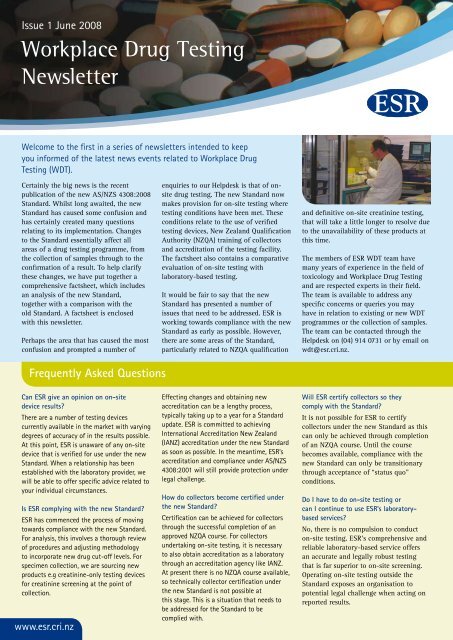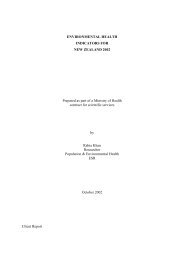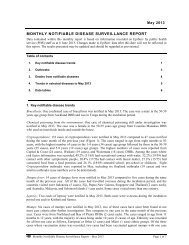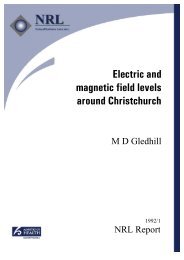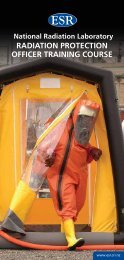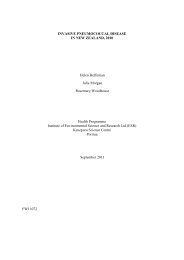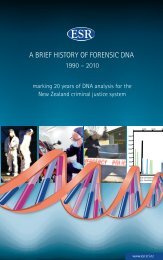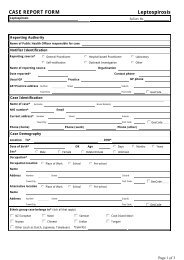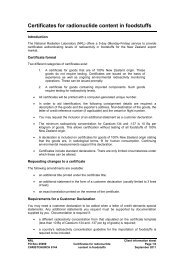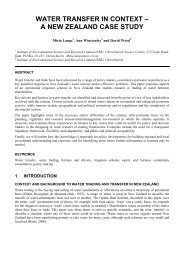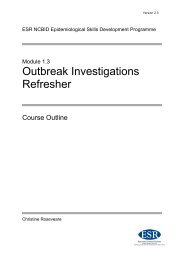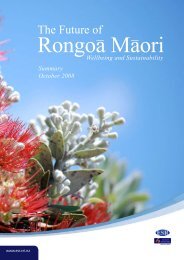Workplace Drug Testing Newsletter - Environmental Science ...
Workplace Drug Testing Newsletter - Environmental Science ...
Workplace Drug Testing Newsletter - Environmental Science ...
Create successful ePaper yourself
Turn your PDF publications into a flip-book with our unique Google optimized e-Paper software.
Issue 1 June 2008<br />
<strong>Workplace</strong> <strong>Drug</strong> <strong>Testing</strong><br />
<strong>Newsletter</strong><br />
Welcome to the first in a series of newsletters intended to keep<br />
you informed of the latest news events related to <strong>Workplace</strong> <strong>Drug</strong><br />
<strong>Testing</strong> (WDT).<br />
Certainly the big news is the recent<br />
publication of the new AS/NZS 4308:2008<br />
Standard. Whilst long awaited, the new<br />
Standard has caused some confusion and<br />
has certainly created many questions<br />
relating to its implementation. Changes<br />
to the Standard essentially affect all<br />
areas of a drug testing programme, from<br />
the collection of samples through to the<br />
confirmation of a result. To help clarify<br />
these changes, we have put together a<br />
comprehensive factsheet, which includes<br />
an analysis of the new Standard,<br />
together with a comparison with the<br />
old Standard. A factsheet is enclosed<br />
with this newsletter.<br />
Perhaps the area that has caused the most<br />
confusion and prompted a number of<br />
enquiries to our Helpdesk is that of onsite<br />
drug testing. The new Standard now<br />
makes provision for on-site testing where<br />
testing conditions have been met. These<br />
conditions relate to the use of verified<br />
testing devices, New Zealand Qualification<br />
Authority (NZQA) training of collectors<br />
and accreditation of the testing facility.<br />
The factsheet also contains a comparative<br />
evaluation of on-site testing with<br />
laboratory-based testing.<br />
It would be fair to say that the new<br />
Standard has presented a number of<br />
issues that need to be addressed. ESR is<br />
working towards compliance with the new<br />
Standard as early as possible. However,<br />
there are some areas of the Standard,<br />
particularly related to NZQA qualification<br />
and definitive on-site creatinine testing,<br />
that will take a little longer to resolve due<br />
to the unavailability of these products at<br />
this time.<br />
The members of ESR WDT team have<br />
many years of experience in the field of<br />
toxicology and <strong>Workplace</strong> <strong>Drug</strong> <strong>Testing</strong><br />
and are respected experts in their field.<br />
The team is available to address any<br />
specific concerns or queries you may<br />
have in relation to existing or new WDT<br />
programmes or the collection of samples.<br />
The team can be contacted through the<br />
Helpdesk on (04) 914 0731 or by email on<br />
wdt@esr.cri.nz.<br />
Frequently Asked Questions<br />
Can ESR give an opinion on on-site<br />
device results?<br />
There are a number of testing devices<br />
currently available in the market with varying<br />
degrees of accuracy of in the results possible.<br />
At this point, ESR is unaware of any on-site<br />
device that is verified for use under the new<br />
Standard. When a relationship has been<br />
established with the laboratory provider, we<br />
will be able to offer specific advice related to<br />
your individual circumstances.<br />
Is ESR complying with the new Standard?<br />
ESR has commenced the process of moving<br />
towards compliance with the new Standard.<br />
For analysis, this involves a thorough review<br />
of procedures and adjusting methodology<br />
to incorporate new drug cut-off levels. For<br />
specimen collection, we are sourcing new<br />
products e.g creatinine-only testing devices<br />
for creatinine screening at the point of<br />
collection.<br />
www.esr.cri.nz<br />
Effecting changes and obtaining new<br />
accreditation can be a lengthy process,<br />
typically taking up to a year for a Standard<br />
update. ESR is committed to achieving<br />
International Accreditation New Zealand<br />
(IANZ) accreditation under the new Standard<br />
as soon as possible. In the meantime, ESR’s<br />
accreditation and compliance under AS/NZS<br />
4308:2001 will still provide protection under<br />
legal challenge.<br />
How do collectors become certified under<br />
the new Standard?<br />
Certification can be achieved for collectors<br />
through the successful completion of an<br />
approved NZQA course. For collectors<br />
undertaking on-site testing, it is necessary<br />
to also obtain accreditation as a laboratory<br />
through an accreditation agency like IANZ.<br />
At present there is no NZQA course available,<br />
so technically collector certification under<br />
the new Standard is not possible at<br />
this stage. This is a situation that needs to<br />
be addressed for the Standard to be<br />
complied with.<br />
Will ESR certify collectors so they<br />
comply with the Standard?<br />
It is not possible for ESR to certify<br />
collectors under the new Standard as this<br />
can only be achieved through completion<br />
of an NZQA course. Until the course<br />
becomes available, compliance with the<br />
new Standard can only be transitionary<br />
through acceptance of “status quo”<br />
conditions.<br />
Do I have to do on-site testing or<br />
can I continue to use ESR’s laboratorybased<br />
services?<br />
No, there is no compulsion to conduct<br />
on-site testing. ESR’s comprehensive and<br />
reliable laboratory-based service offers<br />
an accurate and legally robust testing<br />
that is far superior to on-site screening.<br />
Operating on-site testing outside the<br />
Standard exposes an organisation to<br />
potential legal challenge when acting on<br />
reported results.
AS/NZS 4308:2008<br />
Available Now<br />
AS/NZS 4308:2008 “Procedures for<br />
specimen collection and the detection and<br />
quantitation of drugs of abuse in urine” is<br />
now available. You can obtain your own<br />
copy through the New Zealand Standards<br />
website: www.standards.co.nz/web-shop/.<br />
It can be purchased in downloadable PDF<br />
format or hard copy.<br />
Creatinine <strong>Testing</strong> – Why is it so Important?<br />
An important addition to the new<br />
Standard is the requirement for creatinine<br />
testing of all urine samples at the point of<br />
collection. Creatinine is a metabolic waste<br />
product of muscle activity in the body and<br />
is usually excreted at roughly constant<br />
amounts. Although there is some normal<br />
individual variation in excreted creatinine<br />
levels within a population, a low level<br />
of creatinine may be an indication that<br />
the specimen has been diluted and is<br />
therefore unsuitable for analysis. Dilution<br />
may occur either in the body through an<br />
excessive intake of fluid or outside the<br />
body through the addition of a diluting<br />
liquid after collection. It is important that<br />
a repeat specimen be obtained should the<br />
initial creatinine screening indicate the<br />
possibility of dilution. It may be necessary<br />
to wait a couple of hours to obtain a<br />
suitable repeat specimen.<br />
ESR’s laboratory testing regime has<br />
always included creatinine testing as<br />
part of ensuring the integrity of specimens<br />
and the subsequent accuracy of the<br />
reported results.<br />
A specimen failing a creatinine test,<br />
together with the repeat specimen, must<br />
be sent to an accredited laboratory<br />
for further dilution testing using more<br />
accurate laboratory techniques.<br />
National Fieldays,<br />
Mystery Creek Hamilton<br />
June 11-14 2008<br />
It’s Fieldays time again and this year it<br />
promises to be even bigger and better<br />
than before, with a record number of<br />
exhibitors on site.<br />
ESR WDT will have a presence this<br />
year at this premier event on the<br />
rural calendar and we’d love to see<br />
you at our stand if you are planning<br />
to visit. Statistical research shows<br />
that accidents involving vehicles and<br />
machinery figure highly in rural accident<br />
statistics. Hazards are present on farms,<br />
horticultural enterprises and forests, so<br />
it is important for owners, managers and<br />
contractors to ensure their workplace<br />
environment is as safe as possible. By<br />
taking responsibility for ensuring that<br />
workers are operating machinery and<br />
equipment unimpaired by alcohol or<br />
drugs, a manager shows a commitment<br />
to employee safety and creating a safe<br />
working environment.<br />
So, if you are planning to go to Fieldays<br />
this year, call in and see Eleanor or<br />
Harold at the ESR stand (EX7) in the<br />
Exhibition Hall.<br />
What’s New<br />
Assesssment of the Revised AS/NZS 4308 Standard<br />
ESR has undertaken a comprehensive assessment of the new AS/NZS 4308 Standard and<br />
has published the information in a factsheet format. A copy of the publication is included<br />
with this newsletter, with extra copies available by contacting the WDT Helpdesk on<br />
(04) 914 0731 or by emailing WDT@esr.cri.nz. The assessment includes a summary and<br />
evaluation of the changes to the Standard as well as a comparison of laboratory testing<br />
with on-site testing.<br />
Electronic Reporting of Results<br />
Progress is being made on the electronic reporting of test results. When this comes online,<br />
reporting of results will be faster than ever, with true real-time reporting. This will make<br />
our laboratory-based testing even more efficient, with the clear benefits to our clients of<br />
prompt, accurate reporting that can be acted upon immediately.<br />
WDT Team Update<br />
There have been some changes to the team at WDT over recent months. Sue Nolan,<br />
the face of ESR’s WDT Programme for many of our clients, has left to operate her own<br />
independent consultancy business. Sue is available to our clients for ESR WDT programme<br />
planning, training and policy advice services and can be contacted through Raewyn Brown<br />
at our WDT Help Desk on (04) 914 0731 or by email at WDT@esr.cri.nz. In March this year<br />
the WDT Programme Manager, Shelli Turner, left to take up a position at IANZ in Auckland<br />
as Manager of the Medical <strong>Testing</strong> Programme. Wayne Chisnall, former General Manager<br />
Forensics, is Acting Programme Manager while we recruit Shelli’s replacement. Again,<br />
please contact Raewyn Brown at the WDT Helpdesk in the first instance if you have any<br />
queries at all.<br />
For further information,<br />
please contact:<br />
Help Desk Telephone:<br />
+64 (04) 914 0731<br />
Help Desk Email:<br />
wdt@esr.cri.nz<br />
www.esr.cri.nz<br />
Specialist <strong>Science</strong> Solutions<br />
manaaki tangata taiao hoki<br />
protecting people and their environment through science<br />
www.esr.cri.nz<br />
Copyright © Institute of <strong>Environmental</strong> <strong>Science</strong> & Research Ltd (“ESR”) 2008<br />
All rights reserved. No part of this work covered by copyright may be reproduced or copied in any form or by any means (graphic, electronic or mechanical,<br />
including photocopying, recording, recording taping, or information retrieval systems) without the written permission of ESR.


